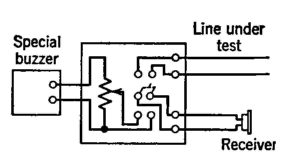| Electrical Communication is a free textbook on the basics of communication technology. See the editorial for more information.... |

|

Home  Interference and Noise Interference and Noise  Noise Measurements Noise Measurements |
|||






|
|||
Noise MeasurementsThe noise-measuring set of Fig. 21 was used for many years. With this set the sound produced in the telephone receiver by the line noise was compared with that produced in the same receiver by a standard buzzer source. The receiver was switched alternately from the telephone line to the buzzer, and the tone adjusted until in the judgment of the listener the noise from the buzzer and that from the line would have the same interfering effect. This was a subjective test, and rather wide deviations in the measured noise were obtained by different observers.
The noise meter now used34 is similar to the sound-level meter described on page 42. The frequency-weighting network is for telephone applications, however. The noise to be measured is, of course, an "electrical," instead of an acoustical, noise, and no microphone need be used. A microphone may be used with the telephone noise meter if desired, converting it into a sound-level meter for acoustical measurements. Measurements are often made of "noise metallic" and of "noise to ground." This latter test is a rough indication of the voltage to which the telephone line is raised above ground. The noise level is measured in decibels above an arbitrary reference value.34
|
|||
Home  Interference and Noise Interference and Noise  Noise Measurements Noise Measurements |
|||
Last Update: 2011-05-30


